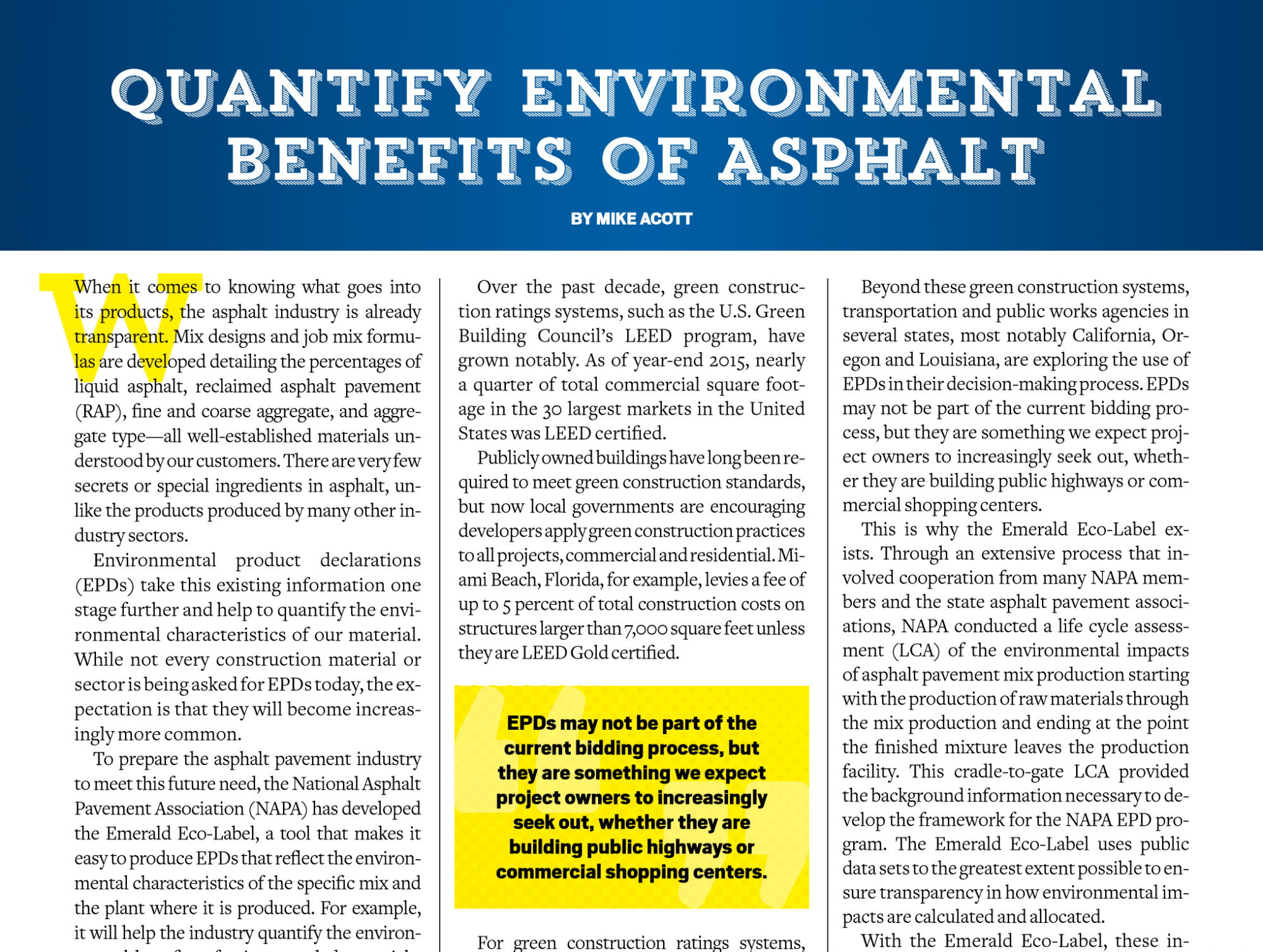Quantify Environmental Benefits of Asphalt
BY Mike Acott

When it comes to knowing what goes into its products, the asphalt industry is already transparent. Mix designs and job mix formulas are developed detailing the percentages of liquid asphalt, reclaimed asphalt pavement (RAP), fine and coarse aggregate, and aggregate type—all well-established materials understood by our customers. There are very few secrets or special ingredients in asphalt, unlike the products produced by many other industry sectors.
Environmental product declarations (EPDs) take this existing information one stage further and help to quantify the environmental characteristics of our material. While not every construction material or sector is being asked for EPDs today, the expectation is that they will become increasingly more common.
To prepare the asphalt pavement industry to meet this future need, the National Asphalt Pavement Association (NAPA) has developed the Emerald Eco-Label, a tool that makes it easy to produce EPDs that reflect the environmental characteristics of the specific mix and the plant where it is produced. For example, it will help the industry quantify the environmental benefits of using recycled materials, particularly RAP, as well as the energy savings provided by warm-mix technologies.
Over the past decade, the asphalt pavement industry has made significant strides in the use of these materials and technologies, and EPDs help make sure we get the credit we deserve.
For example, during the 2016 construction season, warm-mix asphalt (WMA) made up nearly a third of all asphalt production in the United States. An EPD helps make clear how using warm-mix technologies to reduce production temperatures reduces the amount of fuel needed to produce each ton of asphalt paving mixture and the corresponding reduction in environmental impact.
Similarly, on average 20.5 percent RAP was included in asphalt pavement mixtures in 2016. An EPD shows the reduced environmental impact of using reclaimed and recycled materials compared to virgin materials.
Over the past decade, green construction ratings systems, such as the U.S. Green Building Council’s LEED program, have grown notably. As of year-end 2015, nearly a quarter of total commercial square footage in the 30 largest markets in the United States was LEED certified.
Publicly owned buildings have long been required to meet green construction standards, but now local governments are encouraging developers apply green construction practices to all projects, commercial and residential. Miami Beach, Florida, for example, levies a fee of up to 5 percent of total construction costs on structures larger than 7,000 square feet unless they are LEED Gold certified.
For green construction ratings systems, EPDs are an increasingly important requirement. While porous asphalt pavements continue to earn credits for low-impact development and rainwater management, other credits within these systems are now based on the availability of EPDs.
Emerald Eco-Label EPDs are fully compliant with the ISO 14025 and EN 15804 standards, which allows asphalt mix producers to provide the standardized, third-party verified documentation needed for a project to earn a full credit under LEED version 4.
Beyond LEED, the Green Building Initiative’s Green Globes, the International Green Construction Code (IgCC), and the Institute for Sustainable Infrastructure’s Envision system all include incentives for projects to use EPDs. They are also used in the Greenroads rating system for transportation projects, and FHWA’s INVEST sustainable highways self-evaluation tool is working to incorporate EPDs in a future release.
Beyond these green construction systems, transportation and public works agencies in several states, most notably California, Oregon and Louisiana, are exploring the use of EPDs in their decision-making process. EPDs may not be part of the current bidding process, but they are something we expect project owners to increasingly seek out, whether they are building public highways or commercial shopping centers.
This is why the Emerald Eco-Label exists. Through an extensive process that involved cooperation from many NAPA members and the state asphalt pavement associations, NAPA conducted a life cycle assessment (LCA) of the environmental impacts of asphalt pavement mix production starting with the production of raw materials through the mix production and ending at the point the finished mixture leaves the production facility. This cradle-to-gate LCA provided the background information necessary to develop the framework for the NAPA EPD program. The Emerald Eco-Label uses public data sets to the greatest extent possible to ensure transparency in how environmental impacts are calculated and allocated.
With the Emerald Eco-Label, these inputs are combined with plant- and mixture-specific information to output a third-party verified eco-label EPD. A company’s proprietary information is never disclosed; only the environmental impact in several, required categories.
Ours is an industry that has always been able to adapt and change to meet future needs. We have done so with the adoption of WMA, which has had the benefits of reducing energy use, extending the paving season, and reducing emissions. Similarly, the reclamation and reuse of asphalt pavement allows us to turn routine maintenance and resurfacing activities into a harvesting of raw materials for future pavements. EPDs help us quantify and get well deserved credit for the sustainability of our product and of our practices.
Asphalt pavement mix producers are focused on delivering the quality materials owners want for their long-lasting roads, runways, and parking lots. Having the ability to provide an EPD, ensures that asphalt pavements remain the pavement of choice for green construction.
 Mike Acott is the president of the National Asphalt Pavement Association.
Mike Acott is the president of the National Asphalt Pavement Association.
